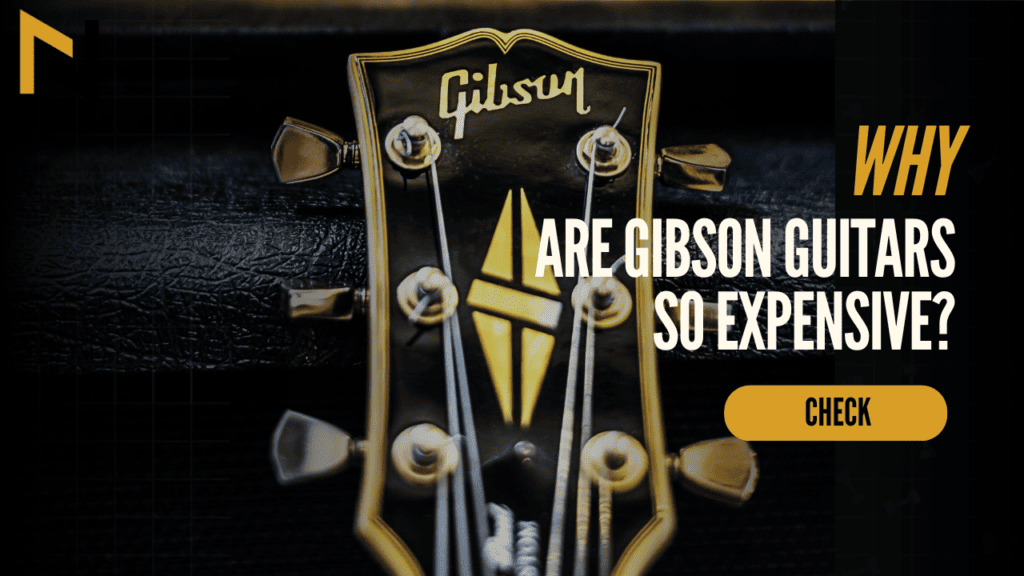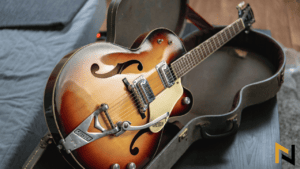I get it. You’re in the market for a classic rock n’ roll guitar and the Les Paul is the prime choice. Can’t blame you. From the 1960s to now, it has been a staple for bold, hard-hitting tones. And this article my friend, helps you to choose between Custom and Standard Les Paul. Thank you for coming here and let’s get into it.

Author: Tyler Connaghan
Tyler Connaghan is a guitarist, singer, producer, composer & engineer based in Los Angeles, California. Tyler has been playing the guitar since 2007. In between writing for guitar publications, he produces music for film and television. His favorite axe is his custom Pelham Blue Fender Stratocaster.
Expertise: music industry, producing, acoustic & electric guitars, songwriting
Bachelor of Science in Music Industry Studies, Music Industry

Editor: Edward Bond
Edward has been playing the guitar since 2002. So Edward has over 20 years of experience as a guitarist, has authored 15 guitar books, has written for renowned music blogs, and spent a decade teaching music. He began merging his passion for writing and music in 2020 and has written for big guitar websites such as Guitar Head Publishing and KillerGuitarRigs.com.
Originally from Seattle, Edward moved to Norway in 2021 for a master’s in music. He’s studied at the Jazz Institute Berlin and Conservatorium van Amsterdam, and currently resides in Trondheim. His education includes a European Jazz Master’s, a diploma in Film and Game Scoring from Sofia, and a Bachelor’s in Jazz from University of Oregon.
Edward has played in numerous bands and currently, Edward works on his own project Starship Infinity
The Les Paul Custom and Standard models are two of the most popular choices in the lineup, though many guitarists aren’t totally sure why they’d choose one over the other.
The Les Paul Custom is the more iconic of these two vintage Gibson guitars, with roots dating back to 1953. It wasn’t until 1958 that the “Burst” Les Paul Standard that we know and love hit the market, before the Les Paul Standard ’60s that would come soon after.
With more than 60 years of innovation behind them and appearances that are eerily similar, it can make people wonder why anyone would be willing to pay so much more for a Les Paul Custom.
Well, after years of playing Gibson electric guitars and getting my hands on each, I’m giving the lowdown on these two iconic models in this Gibson Les Paul Custom vs. Standard guide.
We all know that Les Pauls can be heavy beasts. How do they compare to other electric guitars? Find out in our “How Much Do Electric Guitars Weigh?” post.
Summary (if you’re in a hurry!)
Key Differences Between Gibson Les Paul Custom and Les Paul Standard
- The Gibson Les Paul Custom has a solid mahogany body with a carved maple top, while the Gibson Les Paul Standard has a solid mahogany body and a book-matched maple top.
- The Gibson Les Paul Custom uses an ebony fingerboard on a single-piece mahogany neck. In contrast, the Gibson Les Paul Standard uses a rosewood fingerboard on an asymmetrical slim-taper compound radius mahogany neck.
- The Gibson Les Paul Custom uses a 498T bridge pickup and a 490R neck pickup with a lower output, while the Gibson Les Paul Standard uses Burstbucker Pro pickups on the bridge and neck.
- The Gibson Les Paul Custom uses tulip-style tuning machines, while the Standard has locking Grover tuning machines.
- The Gibson Les Paul Custom is about a pound heavier than the Standard at nine pounds.
Compare the Key Specs for Both Guitars
| Gibson Les Paul Standard | Gibson Les Paul Custom | |
|---|---|---|
| Body | One-piece mahogany body | One-piece mahogany body |
| Top | Book-matched flame maple top | Carved maple top |
| Neck | One-piece mahogany neck | One-piece mahogany neck |
| Fretboard | Bound rosewood fretboard | Ebony fretboard |
| Fretboard Markers | Acrylic inlays | MOP custom block inlays |
| # of Frets | 22 | 22 |
| Tuners | Locking Grover tuners | Kluson Tulip tuners |
| Bridge | Tune-o-matic bridge | Tune-o-matic bridge |
| Pickups | Two Burstbucker pickups | 490R neck pickup and 498T bridge pickup |
| Weight | 8.37 pounds | 9.10 pounds |
Imagine Having The Technique, Gear, and Sound of The GOATS… But Don’t just imagine. Find out.
Joe Satriani
Main Band
Solo Artist
Main Guitar
Ibanez Joe Satriani Signature JS2480
Joe Satriani
| Uniqueness | (4.5) |
| Accuracy | (5.0) |
| Speed | (5.0) |
| Right Hand | (5.0) |
| Techniques | (5.0) |
| Versatility | (3.5) |
| Performance | (4.5) |
| Overall Lead | (5.0) |
| Overall Rhythm | (4.5) |
Tommy Emmanuel
Main Band
Solo Artist
Main Guitar
Maton TE Personal
Tommy Emmanuel
| Uniqueness | (3.5) |
| Accuracy | (4.5) |
| Speed | (5.0) |
| Right Hand | (5.0) |
| Techniques | (5.0) |
| Versatility | (4.0) |
| Performance | (4.0) |
| Overall Lead | (5.0) |
| Overall Rhythm | (5.0) |
Steve Vai
Main Band
Solo Artist
Main Guitar
Ibanez Steve Vai JEM77
Steve Vai
| Uniqueness | (4.5) |
| Accuracy | (5.0) |
| Speed | (5.0) |
| Right Hand | (4.5) |
| Techniques | (5.0) |
| Versatility | (3.0) |
| Performance | (4.5) |
| Overall Lead | (5.0) |
| Overall Rhythm | (4.5) |
Gibson Les Paul Custom Pros and cons
| Pros | Cons |
|---|---|
| Sounds almost identical to the original PAF Les Pauls. | I’m not sure the few-thousand-dollar price bump is justified. |
| Highest-quality tonewoods and hardware. | Slightly heavier than the Standard. |
| Beautiful design. |
Gibson Les Paul Standard Pros and cons
| Pros | Cons |
|---|---|
| Incredible-looking guitar. | Receives less attention to detail than the Custom in the Gibson Custom Shop Factory. |
| Delivers that classic Gibson rock n’ roll sound. | |
| Coil-splitting feature. |
Another treat: Gibson Les Paul Traditional vs Standard
Build Quality & Aesthetics
Custom Shop Appointments
Since its inception, the overall design of the Les Paul Custom hasn’t changed much. According to legend, Les Paul wanted to make a guitar that looked like it was wearing a tuxedo, and voila, the Custom was born.

*Consider all links in this post to be affiliate links. If you purchase, at no additional cost to you, we may earn a small commission. It helps us to keep the lights on, thanks! 🙂
In terms of build quality, this is about as good as it gets in the Gibson lineup. You’ll find a few unique elements that you won’t find on the Gibson Les Paul Standard, such as the front and back 7-ply binding, which gives the guitar its gorgeous contours.
The headstock, which is also multi-bound, comes with the legendary diamond inlay. It’s probably one of the most recognizable headstock designs in Gibson guitar history. Plus, since the Custom is made in the Custom Shop, it gets all the handcrafted attention to detail you don’t get with the Standard.

I recently visited the Gibson Custom Shop in Nashville, and seeing how much love and passion the team puts into their guitar designs is unparalleled.
One of the most significant downsides of the Custom compared to the Standard is that it is slightly heavier. If you play a lot of long live shows, that extra pound could mean the difference between waking up the next day with or without a sore back.
Les Paul Standard
The Les Paul Standard is very similar in terms of design. At first glance, it’d be hard to differentiate these two guitars. Similar to the Custom, it hasn’t changed much since the 1950s, except for a few modern upgrades. For example, you get a thinner neck than the Standard, which can make playing for long periods a lot more comfortable.
Both guitars utilize mahogany bodies and necks, though the Standard has your regular book-matched flame maple top, which, in my opinion, does not look as good as the Custom’s.
One of the big design advantages of the Standard, however, is that there are a few more finishes available if you don’t want a dark guitar.
Hardware
There are many hardware similarities between these two Les Paul models. For example, they share the classic Gibson aluminum Tune-O-Matic tailpiece, which makes for decent tuning stability and sustain.
The main differences lie in the tuning pegs and the hardware color. With the Custom, you get luxurious-looking gold hardware throughout, while the Standard features regular chrome hardware. However, you will find gold reflector knobs on the Standard, which gives it a nice vintage look.
The tuners on the Custom are vintage Klusons, which look nice and hold tune well. However, I’ve always been partial to Grover Rotomatics, which you’ll find on the Standard. They feel a lot more solid and hold tune super well. I feel like the only reason Gibson went with the Klusons on the Custom model was to keep with the vintage specs.
Overall, however, the hardware quality is high on both guitars.
Les Paul Custom vs Standard: Playability & Neck Profile
Both of these guitars also offer a similar level of playability. In recent years, however, Gibson decided to go thinner with the neck profile on the Les Paul Standard, which makes it a bit easier to play, especially for those with small hands. It also has a modern weight relief system, which makes it lighter overall, perfect for playing long shows.
The Custom is just under a pound heavier than the Standard, which can undoubtedly affect the playability if you’re standing, and the neck profile thickness is in line with the Custom models of the ’50s. If you like playing with a chunkier neck, it might actually be ideal.
Les Paul Custom vs Standard: Pickups & Sound Comparison
One of the most apparent differences between these two guitars is the pickups. As you would expect with different pickups, these guitars sound different.
While both still have some characteristics of the ’50s PAF pickups, the Les Paul Custom pickups come closer to the original tone. When you’re in the neck position on the Custom, you get access to the 490R pickup with the Alnico II magnet. It has a slightly lower output than the pickup in the neck position, which is the 498T with an Alnico V magnet.
Overall, the pickup configuration on the Custom is quite versatile, though if I had to categorize the overall tone, the guitar has a slight upper-mid focus, which is great for when you need to cut through busy mixes.
Check these articles too:
Are Ibanez Gio Guitars Good? – Owners Perspective
6 Best Electric Guitar Brands Right Now
Best ESP Guitars – Metal Guitarist Chooses
Best Fender Guitars Right Now: Tyler’s Top Picks
Are Jackson Dinky Guitars Good? – Is The Small Body For You?
5 Best Ibanez Electric Guitars for 2024 (Ibanez Fanboy Picks)
With that said, the Custom is still a bit darker and mellower than the Standard, which features two Burstbucker pickups with Alnico V magnets. While both the neck pickups on the Standard and Custom have a 7.4 output rating, the Custom’s 498T bridge pickup has a 9 output rating, hotter than the Standard’s Burstbucker bridge pickup at 8.3.
In essence, the Custom runs a bit hotter. It’s also worth noting that the team at Gibson wax-potted the Custom’s pickups to mitigate microphonic feedback, so in theory, it’s the better choice for heavy metal and hard rock.
Of course, the brightness on the Standard helps it cut, too, so in reality, either will work for heavy music.
It’s also worth noting that the Les Paul Standard has split-coil pickups, which you can access by pulling out the volume knob. This added modern feature gives you the sound of a single-coil pickup, which I love.
Check out the Les Paul Custom vs. Standard tone comparison video below:
Les Paul Custom vs Standard: Pricing
The price of both these guitars can be a lot to swallow for many players. Even players with the money to throw down on one of these axes wonder if the additional $2,000 price bump on the Custom is justified.
The Custom is no doubt a classy instrument, though, because you can really pull a lot of the same sounds out of the Standard (if not more, thanks to the split-coil design), I can’t confidently say that I would spend that much more to say I have a Custom model. Regarding Les Paul Custom vs. Standard price, the Standard comes out on top.
Why Are Gibson Les Pauls So Expensive?
One of the main reasons that Gibsons are so expensive is that they’re made in the United States, unlike some guitar manufacturers that utilize offshore manufacturing plants throughout countries like Korea, India, China, and Indonesia.

Another thing worth mentioning is that certain materials have undergone legal restrictions over the past few years. With less availability, the price naturally goes up. For example, regulations on rosewood made the material more difficult to access for quite some time, meaning fewer Gibsons were made with it.
As the fundamental laws of supply and demand go, the rarer something is, the more expensive it is, too.
Lastly, many Gibson guitars are made by hand. While many luthiers use CNC machines for basic shaping and wood cutting, they often sand and finish the necks by hand and use nitrocellulose (a tough finish to work with) for their body finishes.
Famous Gibson Les Paul Custom and Standard Players
Hey you. I do not say this because I have to, but because I want to. If you do these 1. Set a clear vision. 2. Show up every day. 3. Do not repeat the same mistakes over and over again….you can do almost anything in life. Remember this. You are in control. Thank you for visiting us here at GND. YOU are the reason we do this.
Teemu – Founder of GND.
Famous Les Paul Custom Players
- Zakk Wylde.
- Kirk Hammett.
- Slash.
- Randy Rhoads.
- Peter Frampton.
Famous Les Paul Standard Players
- Neil Young.
- Billy Gibbons.
- Paul Kossoff.
- Eric Clapton.
- Peter Green.
Alternatives To The Gibson Les Paul Standard and Custom
Not looking to shell out a few thousand dollars to get your hands on these classic Gibson models? You might consider checking out what Epiphone guitars have to offer!
Though they were once a standalone company, Gibson bought out Epiphone in 1957 to eliminate them as a major rival for archtops. Now, Epiphone makes more consumer-friendly versions of iconic Gibson guitars, including the Les Paul Standard and Custom.
While these Les Paul models look the same in many ways, the materials aren’t of the same caliber. From the wood to the hardware to the pickups, all components are made with budget-conscious buyers in mind.
With that said, they aren’t “inferior” guitars by any means. In fact, when faced with the Gibson vs. Epiphone debate, many famous Les Paul players prefer Epiphone, including Noel Gallagher and Gary Clark Jr.
Conclusion
There you have it — our Les Paul Custom vs. Les Paul Standard comparison.
Ultimately, both guitars are highly versatile and offer that classic Gibson sound that gave birth to rock n’ roll as we know it today. If I chose between the two, I’d likely go with the Les Paul Standard. It’s a true 21st-century iteration of the ’50s Les Paul’s classic design, adding the split-coil design and a weight-relief body.
Plus, you save a lot of money you’d otherwise dump on the “tux.”
FAQ
What Is the Difference Between Gibson Les Paul Standard and Custom?
There are many differences between these two guitars, though one of the most glaringly obvious is the pickup configuration.
The Les Paul Custom uses 498R and 498T pickups instead of the Standard’s Burstbucker setup, providing a warmer, mellower sound with a slightly higher output on the bridge.
What Kind of Music Is a Gibson Les Paul Good For?
While Gibson Les Pauls are incredibly versatile guitars, they are often associated with hard rock and metal.
Why Is the Gibson Les Paul Custom So Expensive?
Beyond the fact that they have a long legacy with many iconic artists behind them, Les Pauls are so expensive because they are handcrafted in the United States with the highest-quality materials possible.
What Is the Best Alternative to the Les Paul Custom?
The best alternative to the Les Paul Custom, in my book, would be the Les Paul Standard. However, if you’re on a serious budget, you can go with an Epiphone Les Paul Custom.
Are Les Pauls More Versatile Than Strats?
Though some may disagree, Strats are slightly more versatile than Les Pauls regarding tone. The five-way pickup switch provides slightly more tonal variety.
With entirely different guitar body types and pickups, however, Fender and Gibson are vastly different electric guitar brands with their own pros and cons.
How Can You Tell if a Gibson Les Paul Custom Is Real?
The serial number on the back of the headstock will tell you whether or not the Les Paul Custom you have is real. Gibson presses the “Made in USA” text and the serial number onto its headstock, while counterfeiters will engrave them.
























